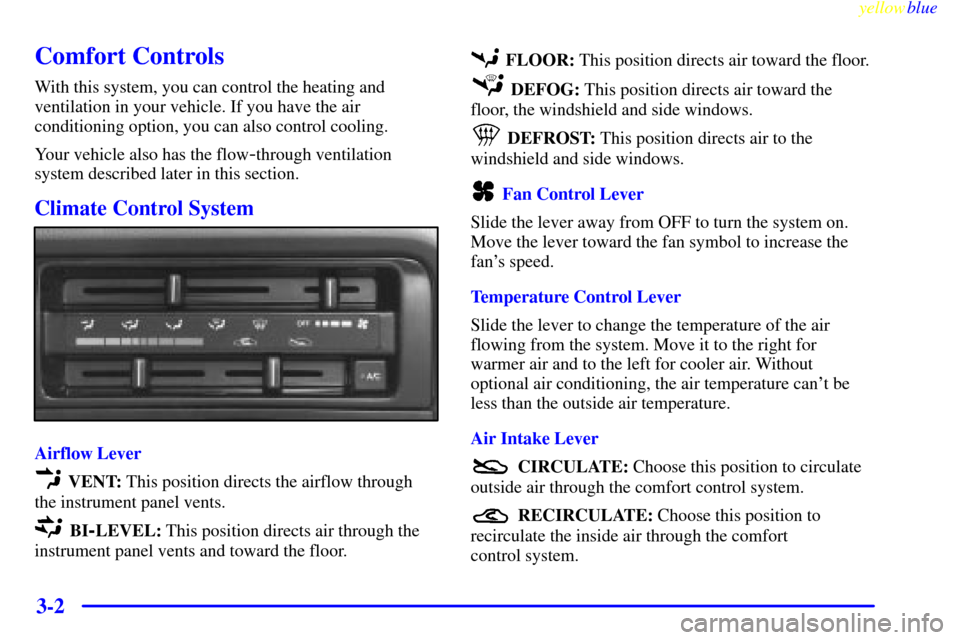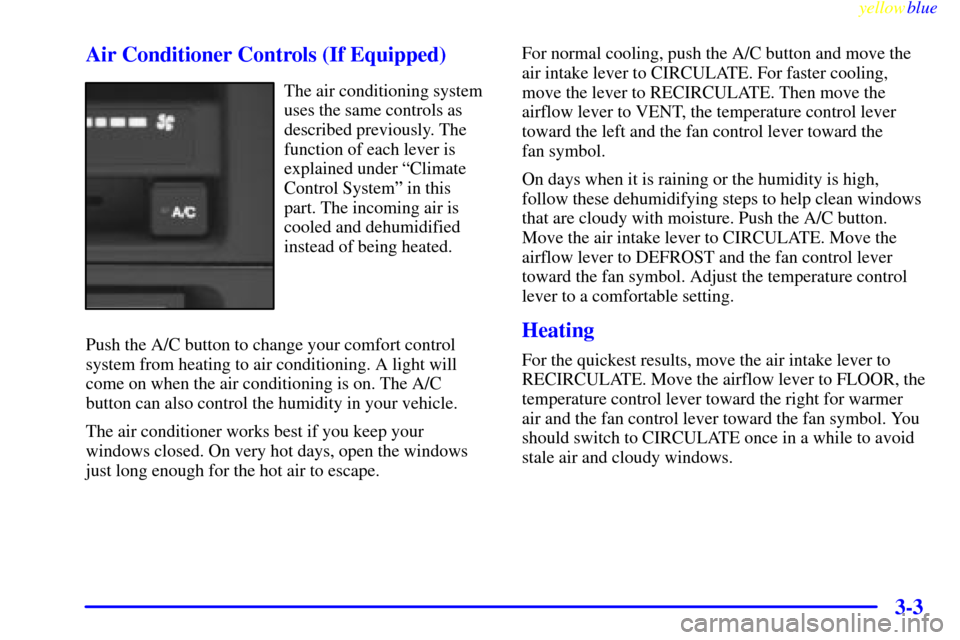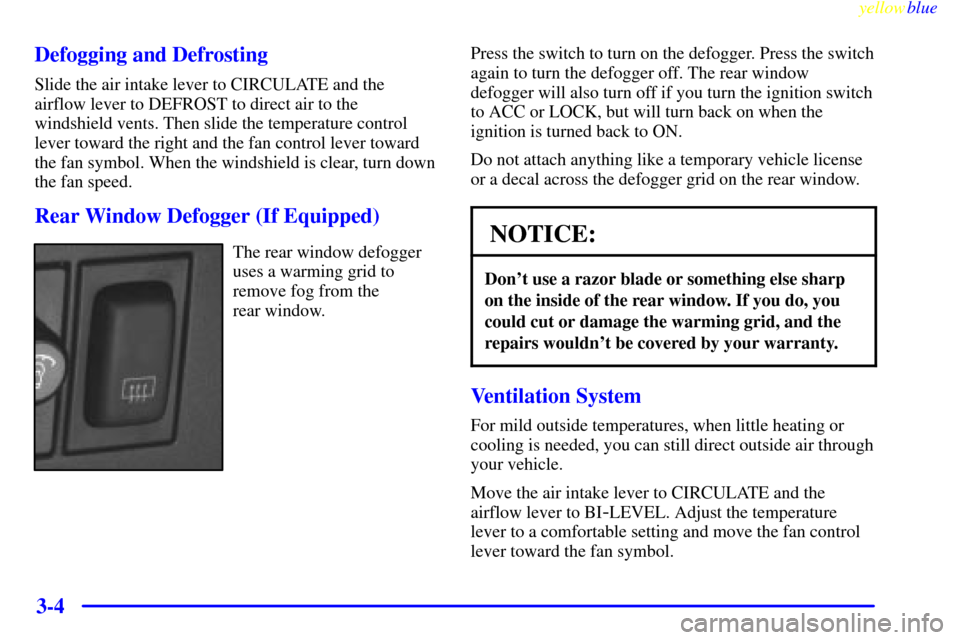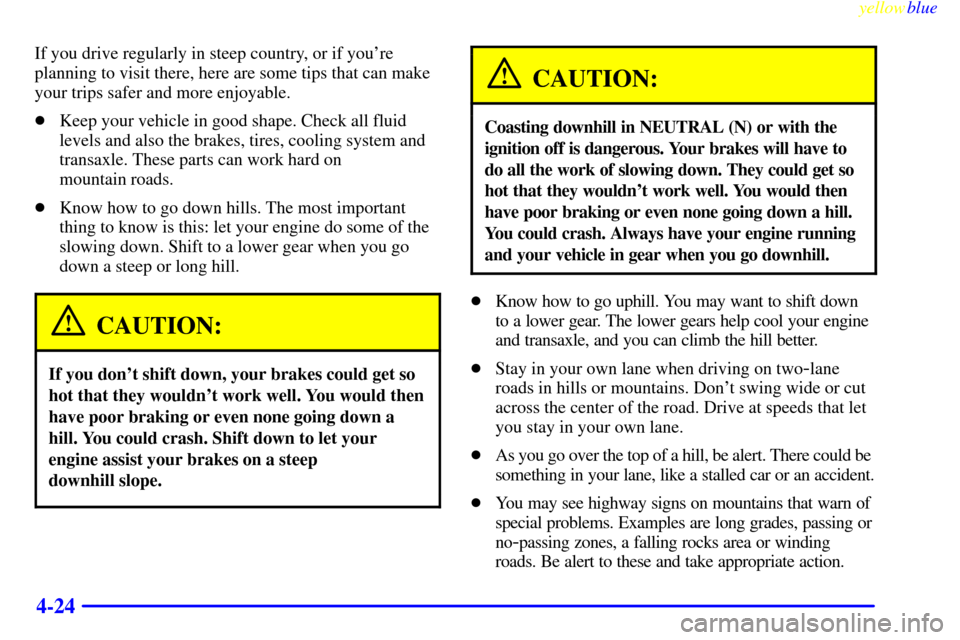Page 65 of 328
yellowblue
2-7 Leaving Your Vehicle
If you are leaving the vehicle, take your key, open your
door and set the locks from the inside. Then get out and
close the door.
Hatchback/Trunk Lid
CAUTION:
It can be dangerous to drive with the hatchback
or trunk lid open because carbon monoxide (CO)
gas can come into your vehicle. You can't see or
smell CO. It can cause unconsciousness and
even death.
CAUTION: (Continued)
CAUTION: (Continued)
If you must drive with the hatchback or trunk lid
open or if electrical wiring or other cable
connections must pass through the seal between
the body and the hatchback or trunk lid:
�Make sure all other windows are shut.
�Turn the fan on your heating or cooling
system to its highest speed with the setting
on CIRCULATE. That will force outside
air into your vehicle. See ªComfort
Controlsº in the Index.
�If you have air outlets on or under the
instrument panel, open them all the way.
See ªEngine Exhaustº in the Index.
Page 108 of 328

yellowblue
3-2
Comfort Controls
With this system, you can control the heating and
ventilation in your vehicle. If you have the air
conditioning option, you can also control cooling.
Your vehicle also has the flow
-through ventilation
system described later in this section.
Climate Control System
Airflow Lever
VENT: This position directs the airflow through
the instrument panel vents.
BI-LEVEL: This position directs air through the
instrument panel vents and toward the floor.
FLOOR: This position directs air toward the floor.
DEFOG: This position directs air toward the
floor, the windshield and side windows.
DEFROST: This position directs air to the
windshield and side windows.
Fan Control Lever
Slide the lever away from OFF to turn the system on.
Move the lever toward the fan symbol to increase the
fan's speed.
Temperature Control Lever
Slide the lever to change the temperature of the air
flowing from the system. Move it to the right for
warmer air and to the left for cooler air. Without
optional air conditioning, the air temperature can't be
less than the outside air temperature.
Air Intake Lever
CIRCULATE: Choose this position to circulate
outside air through the comfort control system.
RECIRCULATE: Choose this position to
recirculate the inside air through the comfort
control system.
Page 109 of 328

yellowblue
3-3 Air Conditioner Controls (If Equipped)
The air conditioning system
uses the same controls as
described previously. The
function of each lever is
explained under ªClimate
Control Systemº in this
part. The incoming air is
cooled and dehumidified
instead of being heated.
Push the A/C button to change your comfort control
system from heating to air conditioning. A light will
come on when the air conditioning is on. The A/C
button can also control the humidity in your vehicle.
The air conditioner works best if you keep your
windows closed. On very hot days, open the windows
just long enough for the hot air to escape.For normal cooling, push the A/C button and move the
air intake lever to CIRCULATE. For faster cooling,
move the lever to RECIRCULATE. Then move the
airflow lever to VENT, the temperature control lever
toward the left and the fan control lever toward the
fan symbol.
On days when it is raining or the humidity is high,
follow these dehumidifying steps to help clean windows
that are cloudy with moisture. Push the A/C button.
Move the air intake lever to CIRCULATE. Move the
airflow lever to DEFROST and the fan control lever
toward the fan symbol. Adjust the temperature control
lever to a comfortable setting.
Heating
For the quickest results, move the air intake lever to
RECIRCULATE. Move the airflow lever to FLOOR, the
temperature control lever toward the right for warmer
air and the fan control lever toward the fan symbol. You
should switch to CIRCULATE once in a while to avoid
stale air and cloudy windows.
Page 110 of 328

yellowblue
3-4 Defogging and Defrosting
Slide the air intake lever to CIRCULATE and the
airflow lever to DEFROST to direct air to the
windshield vents. Then slide the temperature control
lever toward the right and the fan control lever toward
the fan symbol. When the windshield is clear, turn down
the fan speed.
Rear Window Defogger (If Equipped)
The rear window defogger
uses a warming grid to
remove fog from the
rear window.Press the switch to turn on the defogger. Press the switch
again to turn the defogger off. The rear window
defogger will also turn off if you turn the ignition switch
to ACC or LOCK, but will turn back on when the
ignition is turned back to ON.
Do not attach anything like a temporary vehicle license
or a decal across the defogger grid on the rear window.NOTICE:
Don't use a razor blade or something else sharp
on the inside of the rear window. If you do, you
could cut or damage the warming grid, and the
repairs wouldn't be covered by your warranty.
Ventilation System
For mild outside temperatures, when little heating or
cooling is needed, you can still direct outside air through
your vehicle.
Move the air intake lever to CIRCULATE and the
airflow lever to BI
-LEVEL. Adjust the temperature
lever to a comfortable setting and move the fan control
lever toward the fan symbol.
Page 148 of 328

yellowblue
4-24
If you drive regularly in steep country, or if you're
planning to visit there, here are some tips that can make
your trips safer and more enjoyable.
�Keep your vehicle in good shape. Check all fluid
levels and also the brakes, tires, cooling system and
transaxle. These parts can work hard on
mountain roads.
�Know how to go down hills. The most important
thing to know is this: let your engine do some of the
slowing down. Shift to a lower gear when you go
down a steep or long hill.
CAUTION:
If you don't shift down, your brakes could get so
hot that they wouldn't work well. You would then
have poor braking or even none going down a
hill. You could crash. Shift down to let your
engine assist your brakes on a steep
downhill slope.
CAUTION:
Coasting downhill in NEUTRAL (N) or with the
ignition off is dangerous. Your brakes will have to
do all the work of slowing down. They could get so
hot that they wouldn't work well. You would then
have poor braking or even none going down a hill.
You could crash. Always have your engine running
and your vehicle in gear when you go downhill.
�Know how to go uphill. You may want to shift down
to a lower gear. The lower gears help cool your engine
and transaxle, and you can climb the hill better.
�Stay in your own lane when driving on two
-lane
roads in hills or mountains. Don't swing wide or cut
across the center of the road. Drive at speeds that let
you stay in your own lane.
�As you go over the top of a hill, be alert. There could be
something in your lane, like a stalled car or an accident.
�You may see highway signs on mountains that warn of
special problems. Examples are long grades, passing or
no
-passing zones, a falling rocks area or winding
roads. Be alert to these and take appropriate action.
Page 161 of 328
5-
yellowblue
5-1
Section 5 Problems on the Road
Here you'll find what to do about some problems that can occur on the road.
5
-2 Hazard Warning Flashers
5
-3 Other Warning Devices
5
-3 Jump Starting
5
-8 Towing Your Vehicle
5
-8 Engine Overheating5
-11 Cooling System
5
-18 If a Tire Goes Flat
5
-19 Changing a Flat Tire
5
-30 Compact Spare Tire
5
-31 If You're Stuck: In Sand, Mud, Ice or Snow
Page 171 of 328
yellowblue
5-11
Cooling System
When you decide it's safe to lift the hood, here's what
you'll see:
1. Coolant Recovery Tank
2. Radiator Pressure Cap
3. Electric Engine Cooling Fan
CAUTION:
An electric engine cooling fan under the hood can
start up even when the engine is not running and
can injure you. Keep hands, clothing and tools
away from any underhood electric fan.
If the coolant inside the coolant recovery tank is boiling,
don't do anything else until it cools down.
Page 172 of 328
yellowblue
5-12
The coolant level should be at the FULL mark. If it
isn't, you may have a leak in the radiator hoses, heater
hoses, radiator, water pump or somewhere else in the
cooling system.
CAUTION:
Heater and radiator hoses, and other engine
parts, can be very hot. Don't touch them. If you
do, you can be burned.
Don't run the engine if there is a leak. If you run
the engine, it could lose all coolant. That could
cause an engine fire, and you could be burned.
Get any leak fixed before you drive the vehicle.
NOTICE:
Engine damage from running your engine
without coolant isn't covered by your warranty.
If there seems to be no leak, with the engine on, check to
see if the electric engine cooling fan is running. If the
engine is overheating, the fan should be running. If it
isn't, your vehicle needs service.